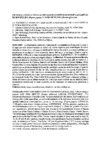Please use this identifier to cite or link to this item:
https://accedacris.ulpgc.es/handle/10553/76190
| Title: | Primeras aportaciones al desarrollo osteológico de las larvas de bocinegro (Pagrus pagrus) y sama de pluma (Dentex gibbosus) | Other Titles: | First contributions to the osteological red porgy (Pagrus pagrus) and pink dentex (Dentex gibbosus) larval development | Authors: | Socorro, J. A. Orán, G. Izquierdo, M. S. Fernandez, A. Caballero, M. J. Fernández-Palacios, H. |
UNESCO Clasification: | 251092 Acuicultura marina | Keywords: | Red porgy Pink dentex Larval development Ossification |
Issue Date: | 1997 | Publisher: | Ministerio de Agricultura, Pesca y Alimentación | Project: | Estudio sobre ia reproduccion y el cultivo larvario del bocinegro (Pagrus pagrus) como nueva especie candidata para la acuicultura (AGF94-0882-C03-01), CICYT | Conference: | VI Congreso Nacional de Acuicultura | Abstract: | La importancia comercial y pesquera de los espáridos en el mercado europeo y el auge que está experimentando el cultivo de nuevas especies que diversifiquen la oferta existente en acuicultura, así como la similitud del sistema de cultivo con otros espáridos que actualmente se producen a nivel comercial, hacen del pargo o bocinegro (Pagrus pagrus, LINNAEUS, 1758) y de la sama de pluma (Dentex gibbosus, RAFINESQUE, 181 O) candidatos potenciales para la acuicultura en la región atlántico-mediterránea. Diversas experiencias llevadas a cabo para obtener la reproducción en cautividad de ambas especies, han sido reali7.adas en la Planta Experimental de Cultivos Marinos del Instituto Canario de Ciencias Marinas, (Gran Canaria, Islas Canarias, España). El presente trabajo tiene como finalidad describir los primeros cambios que se producen durante el desarrollo osteológico en las larvas de bocinegro y sama de pluma durante sus primeros 30 días de vida, comparándolas a su vez con la dorada (Sparus aurata, LINNAEUS, 1758). Para ello se tomaron muestras de larvas durante los días 1 O, 16, 20, 25 y 30 de vida larvaria, las cuales fueron anestesiadas, fijadas en formol al 10% y teñidas con las técnicas de Taylor-Van Dyke (1983) & Dingerkus-Uhler (1977) para evidenciar cartílago y hueso. Se observó que en ambas especies los huesos que antes osifican son los mandibulares y respiratorios permitiendo el buen desarrollo de las funciones de respiración, predación y natación. Toe commercial importance of sparides in the European market and the interest in diversifiying the existing offer in fish aquaculture, as well as the similarity of its cultivation techniques with other sparides cultured at commercial level, point out the red porgy (Pagrus pagrus, LINNAEUS, 1758) and the pink dentex (Dentex gibbosus, RAFINESQUE, 181 O) as potential candidates for the Mediterranean aquaculture. Various experiences designed to obtain the gonadal maturation and reproduction of both species have been realized in the Experimental Station of Marine aquaculture of the Canary Institute ofMarine Sciences, (Gran Canaria, Canary Islands, Spain). Toe present paper describes the first changes that occur during the osteological development both species during the first 30 days of life. For this porpose samples of larvae were taken at days 1 O, 16, 20, 25 and 30 afler hatching. Sampled larvae were anesthetized, fixed in formaline and dyed with the technique ofTaylor - Van Dyke (1983) & Dingerkus-Uhler (1977) to study cartilage and bone. In both species the bones related with respiratory system and predation, allowing the correct development ofthe breathing, predation and swimming functions. |
URI: | https://accedacris.ulpgc.es/handle/10553/76190 | Source: | VI Congreso Nacional de Acuicultura, Cartagena, 9, 10 y 11 de julio de 1997, 5 p. |
| Appears in Collections: | Actas de congresos |
Items in accedaCRIS are protected by copyright, with all rights reserved, unless otherwise indicated.
